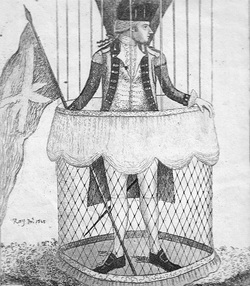 On October 5 1785, Vincenzo Lunardi, a minor Italian noble, famously flew from George Heriot's Hospital in Edinburgh to Coaltown of Collange, near Ceres, in Fife. My ancestors were farmers on several nearby farms, and I like to imagine they were among the crowd who saw Lunardi land. He wasn't the first aeronaut in Scotland - that honour belongs to James "Balloon" Tytler - although he was ultimately more successful than Tytler. [As it happens, Tytler and his wife were Glasites, members of a small but radical Presbyterian sect found by John Glas, who was born on October 5 1695.] The illustration on the left is by celebrated Edinburgh caricaturist, John Kay (1742-1826), from his wonderful Original Portraits. Lunardi evidently enjoyed the attention his ballooning exploits afforded him, as can be seen from this account of his first Scottish flight, 228 years ago today "Melville House, October 5 1785 My Dear Friend, I now proceed to give you the particulars of my late glorious voyage, which in many respects has been the most remarkable I ever made. At twelve o’clock on Wednesday the 5th of this month, I began the operation of filling the balloon, with one pipe from each of the cisterns, communicating with another to which the balloon was connected: at two o’clock it was sufficiently inflated to carry me, with the ballast, instruments &c, but the wind still continuing to blow from the SW I fastened eight bladders to my car; then, having taken in 60lb of ballast, several ropes, a basket of provisions, sent my by Mrs Corri, and a cork jacket with which I was furnished by Dr Rae. I put on my regimentals, and ordered the machine to be carried quite to the eastern part of the area, that the Ladies might have a better view of the ascension. Before my departure, I shook hands with Sir William Forbes, and requested him to advertise, that I would make another experiment on the Wednesday following, for the benefit of the Charity Workhouse.
3 Comments
It’s not every day you have to wait half an hour in a queue to get into a library, but then the Chepman and Myllar Prints are not just any books. They are, to use a term used sparingly by the discerning bibliophile, important. Not to my mind especially because of their content – a series of short chapbooks of vernacular literature in Scots and English, including perhaps my favourite Scots poem, The Flyting of Dumbar and Kennedie – but because of what they represent: the arrival of printing in Scotland. These unique survivors – now bound in a 1951 vellum binding – are a link back over 500 years to what has been regarded as a golden age in Scottish history. They were put on public display yesterday for 2 hours to mark the 500th anniversary of the Battle of Flodden.
Walter Chepman and Androw Myllar founded their press in 1508 under a charter issued by James IV in 1507. James IV is seen as a highly cultured figure, a renaissance prince who, in addition to introducing printing to Scotland, was a patron of the arts generally, and a sponsor of the Scots makars in particular. His reign brought much-needed stability to a Scotland often riven by internecine fighting and the ever-restless Highlands. He finally brought the Lord of the Isles under control in 1493, and built up the Scottish navy of 38 ships, including the Great Michael, at 240 feet and 1000 tonnes the largest ship in Europe at the time of its launch in 1511. James IV’s reign finally came to an end on the battlefield at Flodden, exactly 500 years ago on 9 September 1513. The Scots defeat at Flodden was comprehensive, with thousands dead, with barely a noble family unaffected. The battle did however give rise to two cultural highlights: Walter Scott’s epic poem Marmion, and the haunting lament Flowers of the Forest. Fergus |
Old ScottishGenealogy and Family History - A mix of our news, curious and intriguing discoveries. Research hints and resources to grow your family tree in Scotland from our team. Archives
November 2022
Categories
All
|
- Home
-
Records
- Board of Supervision
- Fathers Found
- Asylum Patients
- Sheriff Court Paternity Decrees
- Sheriff Court Extract Decrees
- School Leaving Certificates
-
Crown Office Cases AD8
>
- AD8 index 1890 01
- AD8 index 1890 02
- AD8 index 1890 03
- AD8 index 1890 04
- AD8 index 1890 05
- AD8 index 1890 06
- AD8 index 1890 07
- AD8 index 1890 08
- AD8 index 1890 09
- AD8 index 1890 10
- AD8 index 1890 11
- AD8 index 1900 1
- AD8 index 1900 2
- AD8 index 1900 3
- AD8 index 1900 4
- AD8 index 1900 5
- AD8 index 1900 6
- AD8 index 1905 1
- AD8 index 1905 2
- AD8 index 1905 3
- AD8 index 1905 4
- AD8 index 1905 5
- AD8 index 1905 6
- AD8 index 1915 1
- AD8 index 1915 2
- Crown Counsel Procedure Books
- Sheriff Court Criminal Records
- Convict criminal records
-
Workmens Compensation Act Records
>
- Workmens Compensation Act Dundee 1
- Workmens Compensation Act Dundee 2
- Workmens Compensation Act Dundee 3
- Workmens Compensation Act Dundee 4
- Workmens Compensation Act Dundee 5
- Workmens Compensation Act Dundee 6
- Workmens Compensation Act Forfar 1
- Workmens Compensation Act Banff 1
- Workmens Compensation Act Perth 1
- Registers of Deeds
- General Register of the Poor
- Registers of Sudden Deaths
- Anatomy Registers
-
Resources
- Blog
- Contact
- Shop
|
Data Protection Register Registration Number: ZA018996 |


 RSS Feed
RSS Feed
